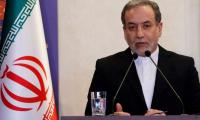My parents used to tell us kids: If you don’t stand for something, you’ll fall for anything. They insisted I grow up with a thorough, varied education and travel the world – to immerse myself in reality and not be completely dependent on what I see on TV or read in the papers. Educationists call this experiential learning.
To this day, education is one of my greatest passions and world travel has become one of my greatest teachers.
Some of my journeys, including India and Pakistan (albeit Pakistan far more extensively), have found me fully immersed within the South Asian cultures for the better part of two decades, thanks to my many South Asian friends from both countries, scattered around the world.
South Asian hospitality and food is without parallel. Which is why I’ve chosen to make Pakistan my second home. It’s been a massive adjustment that hasn’t been easy, but it’s one I believe in.
I keep up with the news and, most recently, found myself befuddled by a rather peculiar matter: a ‘celebration’ of surgical strikes that allegedly took place in Kashmir two years ago, and spurts of random, frenzied media reports suggesting there is more to come.
Just about everyone I know would love for India and Pakistan to work out their political differences. The Indus Waters Treaty, the pervasive Kashmir conflicts to name just a couple. The peoples of both nations, particularly the Kashmiris, have suffered for too long.
The matter of Kashmir can be confusing for Westerners. So, over the years, my humble attempts have included doing a kind of meta-analysis in an effort to try and understand both sides. I’ve read a few books with various accounts of partition, sat with historians and retired military officers from both sides, traveled extensively across Kashmir (was there late summer of 2016 and again this summer). My goal is to find the truth somewhere in the middle of it all.
This current media mayhem reminds of me of a pattern going back to historical accounts dating to early November 1947, when Prime Minister Nehru made a radio address asking the United Nations to supervise a referendum in Kashmir. To paraphrase Hasan Sidiq in his book The End of The Great Game: One month later a meeting was held in Lahore so that India and Pakistan could sort out the outstanding settlement of assets, including cash and military supplies. But the assets would be delayed for months after partition. On 16 January 1948, the Hindustan Times reported that India finally released Pakistan’s cash reserves that India had previously agreed to under the supervision of Mountbatten. Not only did India not fulfill its part of a pre-negotiated agreement, it unlawfully withheld Pakistan’s cash reserves as part of a strategy to create a financial stranglehold on Pakistan and attempt to force it to vacate Kashmir.
Fast forward to today: now the Indian Army Chief is quoted as saying he wants “another surgical strike” across the Line of Control (LoC).
What surfaces for me is a pattern, a correlation, between some of these communications and alleged attacks. If one reviews the “cease fire complaints” issued from India’s side, one might notice a remarkable pattern of timing: August. What happens this time of year? Notably, the UN General Sessions begin soon thereafter, in September.
India makes a claim; requests UN supervision; delays, defers pre-negotiated agreements as part of a greater strategy which Pakistan has fallen prey to. This is not to say that Pakistan has been without blame – far from it. However, India knows how to push Pakistan’s emotional and psychological buttons and, far too often, Pakistan has responded in a manner consistent with – at the very least – instability, coupled with ineffective communications. Further reinforcing the notion of Pakistan’s ‘guilt’ in Western minds – which is precisely what India wants: manufacture a problem, create a faulty perception, reinforce that India is the good guy and Pakistan is the bad guy.
India has been very good at communicating precisely what it wishes the world to hear, attracting millions upon millions of tourists every year, etc. From political lobbying to Bollywood, what many have been conditioned think when they hear “India” is beautiful dancing girls in swirling, colourful lenghas and white sandy beaches of Goa. I digress.
In school, I recall a few of my teachers saying: ‘Cynthia asks many questions.’
To this day, I’m unsure if it was a complaint or compliment. Asking questions can make people uncomfortable, especially if they don’t know the answer or don’t want the answer to come to light. Me being me, naturally I have a few questions:
What is a surgical strike? What happens prior to a strike? What happened after this alleged strike? What was the response from both sides? Is the timing of these complaints and so-called celebrations important? If so, why? Are there patterns to look for? If so, what are the patterns and are they significant? Were the international media able to access the region, if so what was their impression?
A Google search provides some answers:
A definition of surgical strike can include legal and political definitions. Militarily speaking, a universally held definition involves some form of aircraft targeting pre-defined enemy areas – this involves precision-guided weapon systems.
Just prior to an airstrike occurring, in this scenario: Pakistan’s Air Defense Alert SOP would have alerted Pakistan the moment India’s aircraft took off, automatically engaging Pakistan’s Air Defense Systems.
Further, there is a hotline contact between the Directors General Military Operations (DGMO) of Pakistan and India. Every week, they routinely apprise one another of their troops’ activities, etc. The same day this call was made, the DGMO of India did not communicate any incident to the DGMO of Pakistan. Pakistan would later come to hear of the ‘strike’ in the media.
Kashmir is a nuclear flashpoint. Every inch of the Line of Control (LOC) is guarded by ground troops on both sides. It seems reasonable to conclude that if a strike occurred, it would have been considered an act of war and we all would have heard about it. Additionally, I was traveling throughout Kashmir in 2016 (and again this summer) and heard nothing about this from the locals – a highly communicative culture.
After approximately 6 months of the original ‘complaint’, India came up with a video and some satellite imagery which – in and of itself – does not prove anything. Some of India’s own media and members of Parliament have called into question the veracity of the claims. The Indian Information Ministry offered a different account from that of its own military operations.
Pakistan, for its part, took foreign media (approximately 50 journalists) within a couple of days to the location on Pakistan’s side, where nothing closely resembling a strike was detected, as an easily discovered CNN report corroborates. Further, Pakistan offered a joint investigation into the matter – which India rejected.
This month, India’s Defense Minister, Nirmala Sitharaman, announced organizing events from September 28 to 30 to commemorate the valour of soldiers as part of a national strike day.
While I believe all service women and men who serve their countries with honour and integrity should be respected, this particular sequence of events appears to be a clumsy attempt at political machinations – enough to make a semi-educated person LOL with disdain and despair. While India has, historically, been superior in its perception management and communications abilities, India’s opposition parties are feverishly challenging Prime Minister Modi – who is battling corruption charges.
Political pressure has morphed into political posturing; and in its blind quest for domination and power, India has recently crossed a non-sensical line that is nothing more than an attempt to divert attention from the Kashmiri uprising.
Court’s decision to seek report indicates that it will examine whether conditions in jail meet required standards
MNFSR told NA that current stocks and estimated 2025 production are sufficient to meet national needs for 2025-26 food...
Deputy Attorney General responded that the issue regarding Islamabad’s jurisdiction has been resolved
Ansar Kayani Advocate said all of the accused were nominated after the identity parade and not initially
It is important to note that country is declared either polio-endemic or polio-free, under global eradication protocols
Research assessed decades of child nutrition data in low- and middle-income countries, including Pakistan







